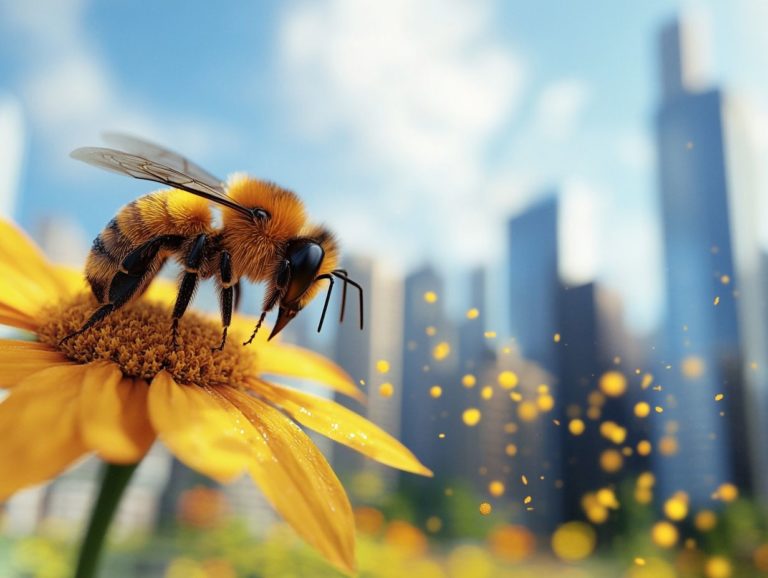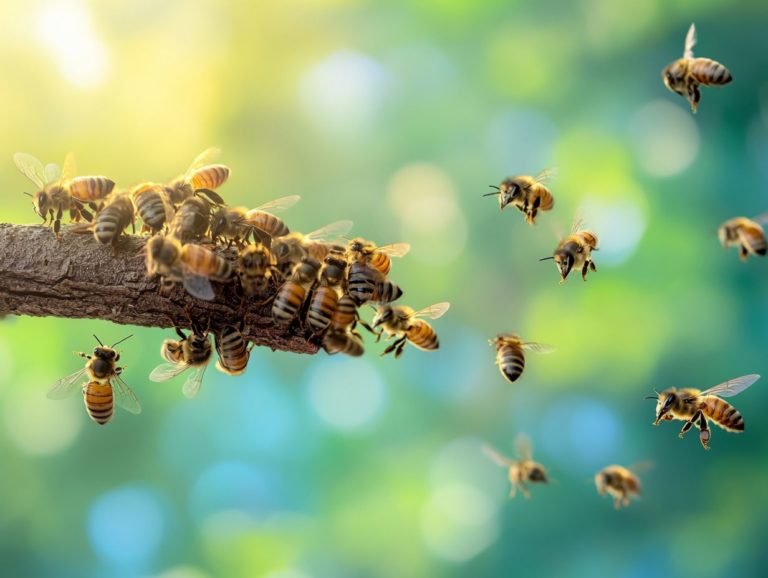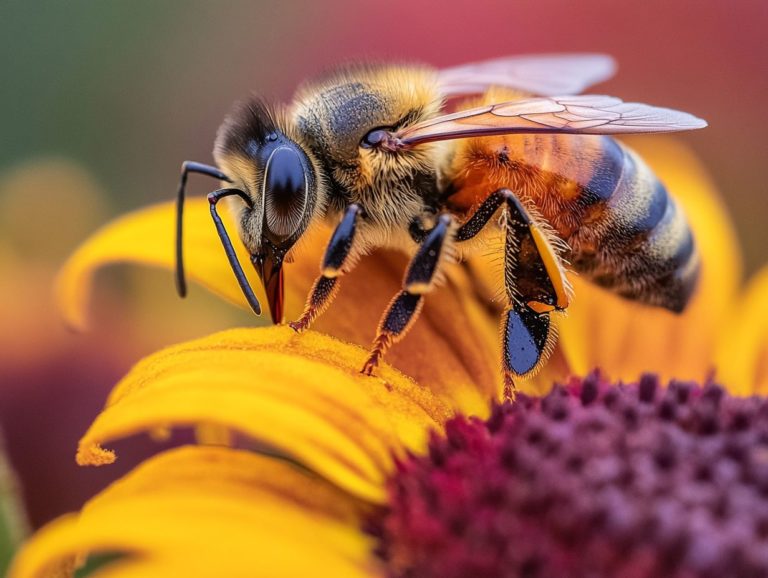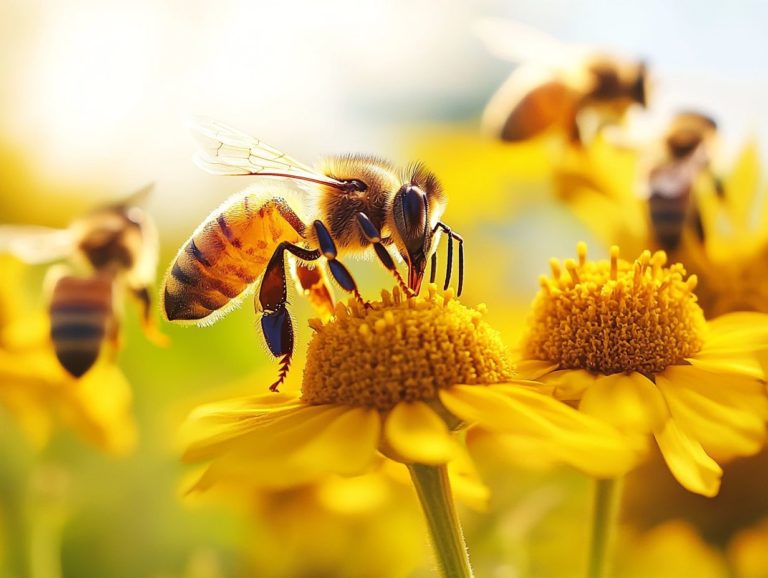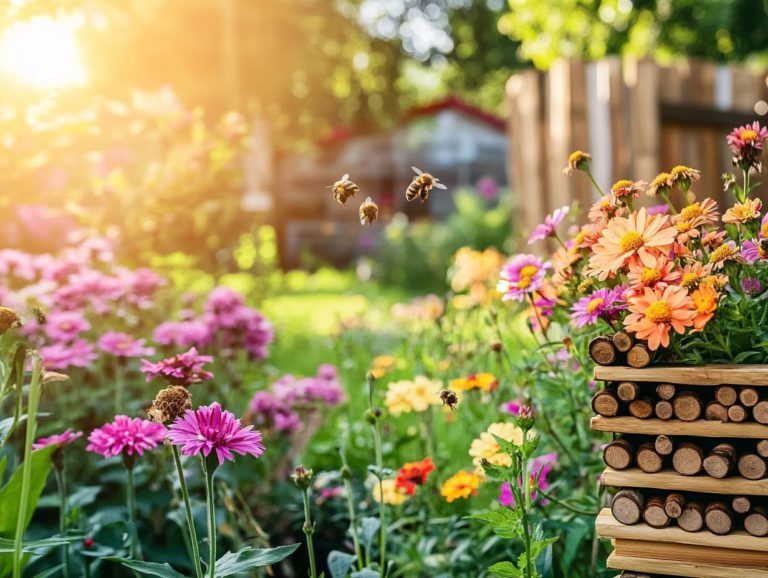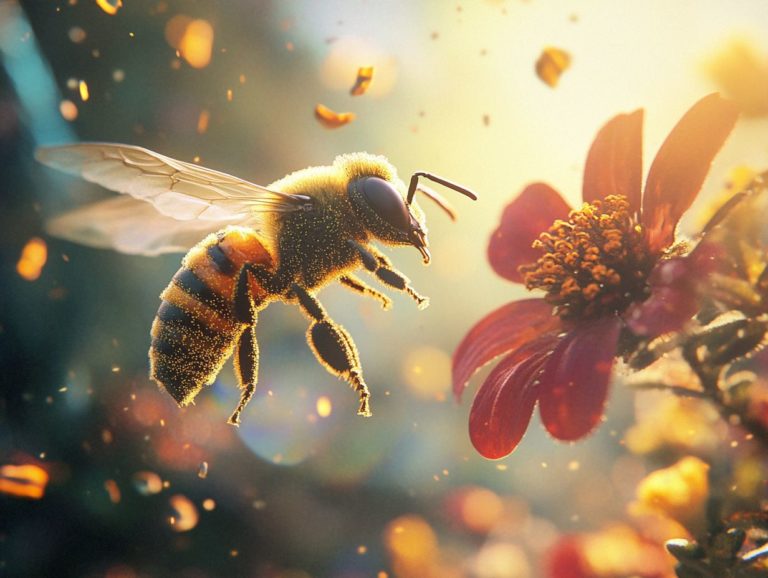How to Support Local Bee Species
Bees are essential to your ecosystem, serving a pivotal role in pollinating many of the plants that you rely on for food, including honey production, and the natural beauty that surrounds you. They contribute to wildlife support and the proliferation of native wildflowers.
However, local bee species encounter a multitude of threats from pesticide exposure, habitat loss, and the encroachment of invasive species. These threats are worsened by climate change and challenges associated with urban beekeeping.
Gaining a comprehensive understanding of these challenges is the crucial first step toward making a meaningful difference.
Dive in to discover how you can make a real difference for local bees! This article will explore the importance of supporting local bees, detail the specific dangers they face, including threats from pesticides and climate change, and outline practical steps you can take to help ensure their survival.
Embrace the opportunity to foster a thriving environment for these extraordinary pollinators by creating bee-friendly gardens and promoting biodiversity!
Contents
- Key Takeaways:
- Why Should We Support Local Bee Species?
- What Are the Threats to Local Bee Species?
- How Can We Help Local Bee Species?
- What Are Some Common Misconceptions About Bees?
- How Can We Spread Awareness and Encourage Others to Support Local Bees?
- Frequently Asked Questions
- What are some simple ways to support local bee species?
- Why is it important to support local bee species?
- How can I create a bee-friendly environment in my garden?
- What types of plants are best for supporting local bee species?
- What should I do if I encounter a bee hive in my yard?
- Can I support local bee species if I live in an urban area?
Key Takeaways:
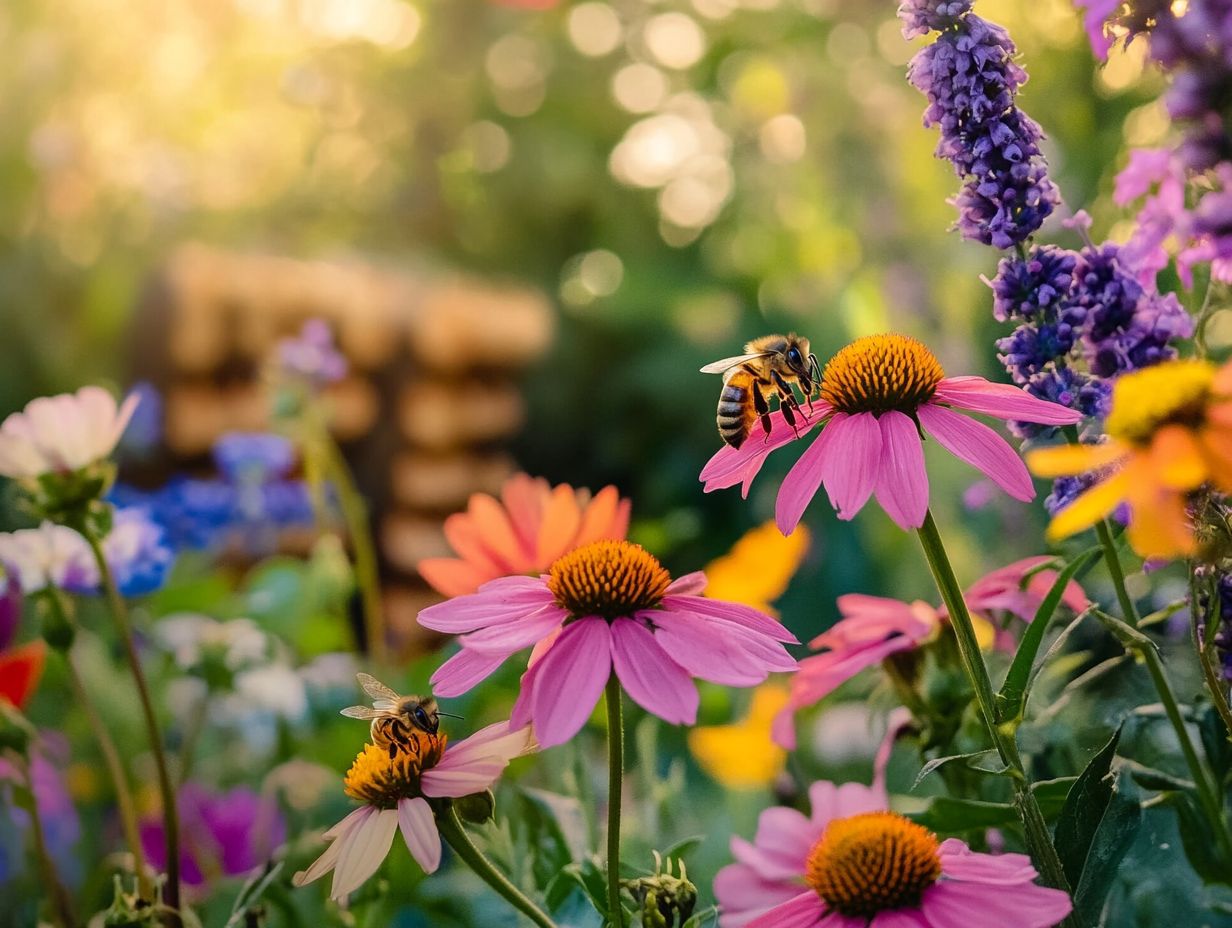
- Supporting local bee species is crucial for maintaining a healthy ecosystem and ensuring the survival of important pollinators.
- Pesticides, habitat loss, climate change, and invasive species are some of the biggest threats to local bee populations. Garden pests and unsustainable honey practices also pose challenges.
- Actions like planting native flowers, avoiding pesticides, and supporting local beekeepers can make a big difference in protecting local bee species.
Why Should We Support Local Bee Species?
Supporting local bee species is vital for maintaining biodiversity and ensuring the health of your ecosystems. Bees serve as essential pollinators, facilitating the reproduction of numerous flowering plants. This, in turn, supports wildlife and enhances food production.
Given the concerning trends in habitat loss, the impacts of climate change, and the need for pesticide-free environments, engaging in bee conservation efforts becomes crucial not just for safeguarding these critical insects but also for encouraging community involvement in fostering a more sustainable environment.
By recognizing the significance of native bee species, including solitary bees and ground-nesting bees, you can take meaningful actions to protect their populations and habitats through planting native plants and creating bee-friendly gardens.
What Are the Threats to Local Bee Species?
Local bee species encounter a multitude of threats that jeopardize their populations and the vital services they render to ecosystems. Habitat loss from urban development, agricultural practices, and climate change severely limits the availability of nectar-rich plants, which are plants that produce sweet liquid that bees love, and suitable nesting sites essential for their survival.
The use of pesticides and the introduction of invasive species also challenge these crucial pollinators, disrupting their natural behaviors and leading to a decline in their numbers. The adverse effects of climate change further compound these issues on their habitats.
Recognizing these threats is imperative for crafting effective conservation strategies aimed at safeguarding our bee populations.
Join the movement to protect our bees and plant a bee-friendly garden today!
What Are the Effects of Pesticides on Bees?
The effects of pesticides on bees are significant and can lead to alarming declines in their populations. This impacts not only their health but also the broader biodiversity of our ecosystems. Pesticides can make it harder for bees to find food, impair their navigation, and even increase mortality rates.
These harmful consequences pose a serious threat to honey production and the crucial pollination services that bees provide for many flowering plants and crops. It s essential to understand alternatives, such as natural pesticides, and the benefits of organic farming practices. These efforts can foster a healthier environment for these vital pollinators.
This understanding opens the door to a range of sustainable practices designed to protect these essential creatures. You can explore integrated pest management strategies that prioritize natural predators that help control pests or embrace organic farming practices that reduce chemical use. By fostering a diverse array of native plants, you ll create habitats that support thriving bee populations.
Prioritizing biodiversity not only boosts the resilience of ecosystems but also ensures that bees and other pollinators can continue their essential roles in maintaining the delicate balance of food production and ecological health. Community involvement in planting flowers and creating habitats is crucial in these conservation efforts.
How Does Habitat Loss Affect Bees?
Habitat loss presents a critical threat to bees by reducing access to essential resources like food and nesting sites. As urban areas expand and agriculture intensifies, the natural landscapes that once hosted diverse, nectar-rich plants are destroyed, leading to a decline in bee populations.
Ground-nesting bees, which need undisturbed soil for their nests, are especially hard-hit by habitat fragmentation. This loss affects not only individual bee species but also disrupts the overall health of pollinator habitats, which are vital for biodiversity.
Different bee species respond uniquely to these changes. For instance, solitary bees, which often have specific floral preferences, are particularly vulnerable as their favored plants disappear. The repercussions of habitat loss ripple through ecosystems, highlighting the need to preserve diverse pollinator habitats. Conservation initiatives aimed at protecting native plants can create vibrant environments that benefit bees and other pollinators.
By ensuring these habitats are rich in biodiversity, you help stabilize ecosystems crucial for food production and environmental health, ultimately supporting a wide range of species, including those at risk.
What Are the Dangers of Invasive Species for Bees?
Invasive species pose significant threats to local bee populations by disrupting natural ecosystems and competing for vital resources. These non-native plants can easily outcompete native flora, reducing the availability of nectar-rich plants that bees depend on for food.
As native plants decline, biodiversity suffers, upsetting the delicate balance that supports pollinators. Recognizing the impact of invasive species is crucial for developing effective conservation strategies that protect our local bee species and their habitats.
For example, the introduction of species like purple loosestrife and Japanese knotweed can quickly take over and block access to local flora. This competition for resources creates a domino effect, leading to dwindling bee populations and destabilizing entire ecosystems.
Since bees are critical pollinators, their decline can result in lower plant reproduction rates, further threatening biodiversity. Therefore, tackling the challenges posed by invasive species is absolutely vital to act now to save our bees and the intricate web of life they support!
Join local efforts to plant native flowers and support our bees today!
How Can We Help Local Bee Species?
There are many opportunities to help local bee species thrive. Start by creating bee-friendly habitats and planting native flowers. Cultivating gardens rich in nectar-producing plants provides essential resources that support bee populations and enhance biodiversity.
Supporting local beekeepers encourages sustainable honey production and fosters community involvement in bee conservation efforts. These actions greatly contribute to the health and survival of these vital pollinators.
1. Plant Native Flowers and Plants
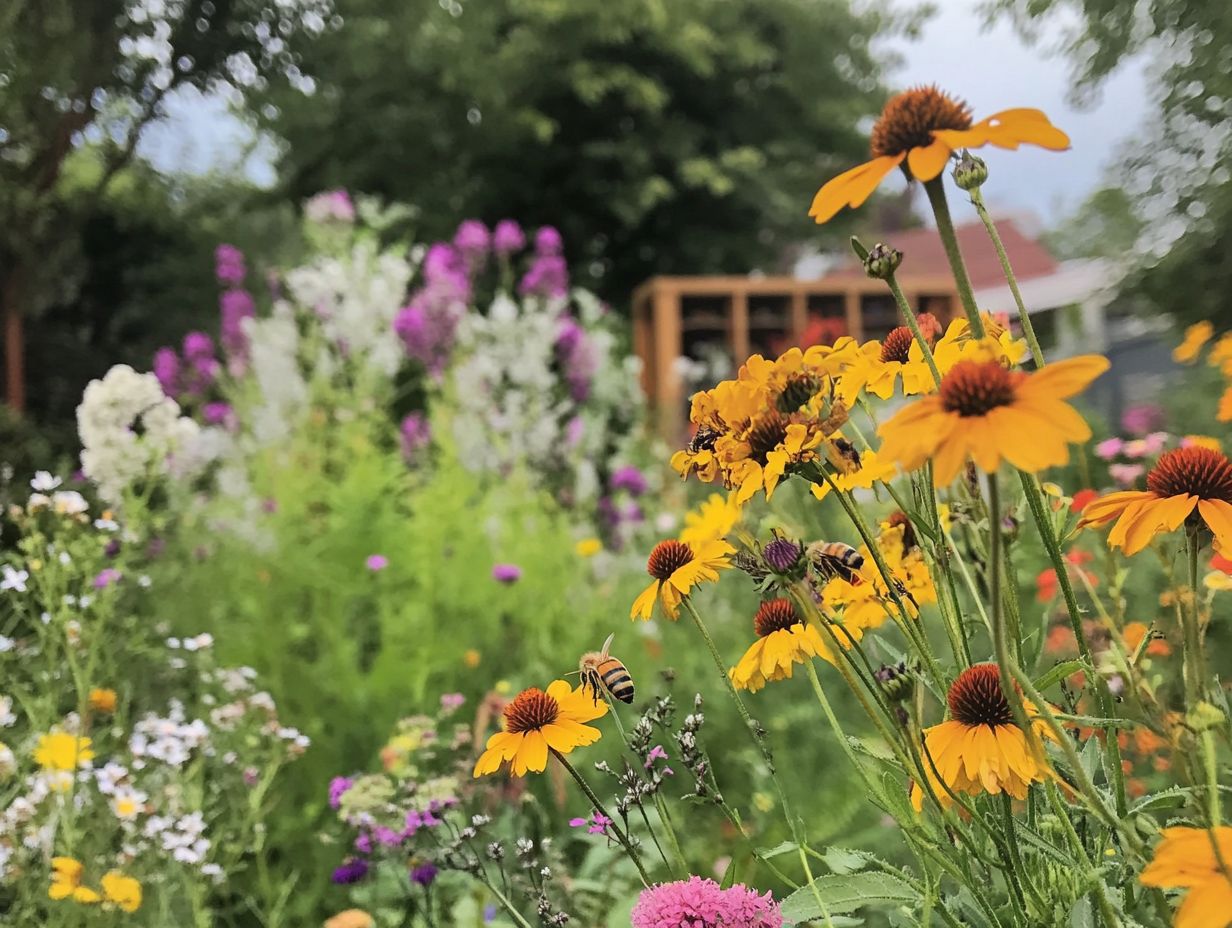
Planting native flowers and plants effectively supports local bee species by providing them with important food sources. Native plants thrive in your local environment and require minimal pesticides or watering, making them a sustainable choice for your bee garden.
Incorporating a variety of nectar-rich plants that bloom throughout the seasons attracts diverse bee species and enhances pollination activity in your garden.
Different native flowers offer unique benefits. Early bloomers like crocuses and willows provide important food in the spring when bees emerge from hibernation. As summer arrives, vibrant echinacea and black-eyed Susans serve as essential food sources during peak foraging times. In autumn, asters and goldenrods ensure bees have food access as they prepare for winter.
By cultivating a rich assortment of flowering plants for each season, you can create a thriving ecosystem that supports various bee species, ultimately enhancing their health and populations. Imagine your garden as a vibrant sanctuary, full of life and buzzing with bees!
2. Create Bee-Friendly Habitats
Act now to create bee-friendly habitats that these vital pollinators urgently need. Build insect hotels to provide nesting sites for solitary bees and incorporate a variety of flower patches that serve as food sources.
Establishing designated pollinator zones within your gardens or community spaces boosts the availability of these vital resources, fostering an environment that supports thriving bee populations.
When designing insect hotels, consider using materials like untreated wood, bamboo, and hollow stems to attract a delightful array of bee species. Natural materials are crucial in wildlife conservation efforts.
In your pollinator zones, maintaining diverse plant life from native wildflowers to flowering shrubs ensures continuous blooms throughout the seasons. This diversity satisfies the foraging preferences of various bee species and enhances overall pollination efforts.
By providing these varied habitats, you and your community can play a vital role in bee conservation, creating healthier environments for these essential pollinators and enriching local biodiversity.
3. Avoid Using Pesticides
Avoiding pesticides is crucial for protecting local bee populations and ensuring their health and productivity.
Pesticides threaten bees and disrupt the balance of ecosystems by harming beneficial insects.
Choose natural pesticides and organic gardening methods. This creates a safe haven for bees and supports sustainable farming.
Consider pesticide-free methods such as introducing garden pests like ladybugs to control harmful insects.
The decline in bee populations, often linked to harmful chemical exposure, underscores the urgent need for a transformation in agricultural methods.
When you choose alternatives like neem oil or insecticidal soaps, you re not just safeguarding bees; you re also helping the environment thrive.
Implementing organic practices enhances soil health and plant vitality. It also cultivates habitats that attract a diverse array of pollinators.
With this mindful approach, your community can witness revitalized biodiversity, contributing to a flourishing environment where bees thrive. This creates healthy gardens and a vibrant ecosystem that benefits everyone.
Creating pollinator gardens and using tree blooms can further support this initiative.
4. Support Local Beekeepers
Supporting local beekeepers is a remarkable way to contribute to the health of bee populations while promoting sustainable honey production.
When you purchase honey and other bee-related products from local sources, you ensure that your support benefits the community directly and encourages environmentally friendly beekeeping practices.
Moreover, advocating for organic honey and urban beekeeping can help diversify local beekeeping initiatives.
Get involved! Organize fun activities like building an insect hotel an insect hotel provides shelter for beneficial insects or creating a bee garden to provide habitat for various bee species.
By engaging in bee education initiatives, you can help raise awareness about the vital role bees play and the challenges they face, nurturing community involvement in conservation efforts.
When you advocate for local beekeepers, you enhance local economies. Your support helps generate jobs and stimulates agricultural diversity.
Supporting community gardens strengthens these efforts.
Participating in community-supported agriculture (CSA) programs allows you to forge direct connections with beekeepers, fostering a shared commitment to sustainable practices.
This engagement supports pollinator habitat creation and wildlife support.
Ready to make a real difference? Join workshops and volunteer for local beekeeping associations today!
By taking these steps, you not only educate yourself but also empower others to appreciate the significance of bees in our ecosystem.
5. Educate Others About the Importance of Bees
Educating others about the importance of bees is vital for fostering conservation efforts. By sharing what bees do for biodiversity and local plants, you can inspire action in your community.
Workshops, community talks, and school programs can really boost awareness and understanding of the challenges bees face. Creating interactive exhibits can captivate a diverse audience, from families to students.
Targeting specific groups, such as gardeners, farmers, and educators, helps ensure that the information resonates with those who can make a difference. Engaging in community projects where people work together can also amplify these efforts.
Using social media platforms can further spread these messages, fueling discussions about the vital relationship between bees and plants. Highlighting the importance of bee-friendly gardens and simple practices like providing sugar water or a bee bath can make a significant impact.
By showcasing local flora and its dependence on bee activity, you nurture an appreciation for native plants and strengthen the community’s connection to the natural environment. This ultimately fosters a collective commitment to safeguarding bee populations.
What Are Some Common Misconceptions About Bees?
Despite their undeniable importance, there are several common misconceptions about bees that cloud our understanding of their roles and behaviors. Many people mistakenly think that all bees are aggressive and will sting at the slightest provocation. In reality, most bee species are quite docile and only sting when they feel threatened.
Another myth is the belief that all bees produce honey. This is only true for honeybees among the vast array of bee species. By addressing and dispelling these misconceptions, we can cultivate a deeper appreciation for the incredible diversity of bees and their essential contributions as invaluable pollinators.
1. Bees Are Aggressive and Will Sting
One of the most common misconceptions is that bees are aggressive and will sting without provocation. In fact, most bee species are quite gentle, stinging only when they perceive a threat.
By understanding the behaviors of different bee species, you can alleviate fears and foster a harmonious coexistence with these remarkable creatures. Knowledge of bee identification and their habitats supports this understanding.
For example, the European honeybee and the bumblebee are known for their docile nature. They focus on pollinating flowers rather than bothering people. Introducing flower patches and tree nesting sites can encourage their presence.
Their buzzing often signals curiosity rather than aggression. Understanding pollination activity and flower shapes helps prevent misinterpretation.
To identify these gentle bees, note their distinctive markings: honeybees display a golden-brown hue with black stripes, while bumblebees are robust and covered in fuzzy hair. By respecting their space and avoiding sudden movements or loud noises, you can greatly reduce the likelihood of a sting.
Simple actions like planting dandelions and clover in your yard can help support native bee species. Join the movement to protect these essential pollinators!
2. All Bees Produce Honey
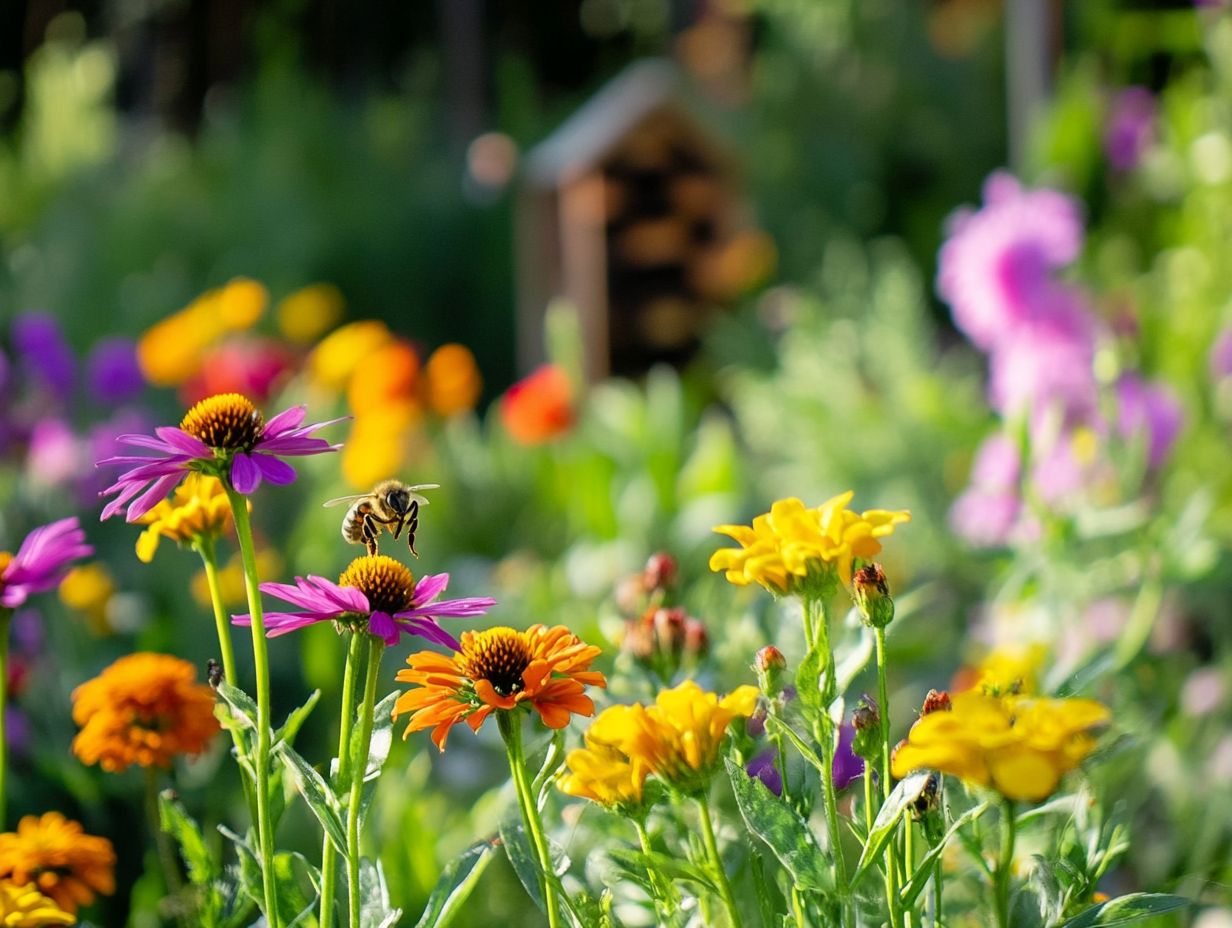
One prevalent misconception is that all bees produce honey. In reality, only honey bees have this ability.
Honey bees are famous for their honey. However, many native bee species are crucial pollinators that don’t produce honey.
The fascinating diversity among bees extends beyond just honey production. It includes their behaviors and habitats as well.
Some species prefer a solitary lifestyle. In contrast, others thrive in social colonies.
Take bumblebees, for example; they’re exceptional pollinators that flourish in cooler climates. Mason bees are solitary artisans, expertly nesting in small, hollow spaces.
Each bee species plays a unique role in the ecosystem. They aid in the fertilization of various plants that support entire food webs.
Understanding these differences helps us appreciate their invaluable contributions. This knowledge can inspire conservation efforts to ensure the survival of all bee species.
Engaging with experts like David Attenborough through documentaries and books can enhance your understanding. This, in turn, sustains the ecosystems that depend on pollination.
3. Bees Are Just a Nuisance
The notion that bees are simply a nuisance fails to recognize their vital role as pollinators. They are essential for maintaining biodiversity and the health of our ecosystems.
We must tackle habitat loss and climate change to ensure bees thrive! Without them, many flowering plants would struggle to reproduce.
This disruption could trigger the decline of various plant species. These plants provide crucial habitats for countless organisms.
Supporting planting flowers and creating pollinator habitats can mitigate these effects. For example, if bees disappeared, the production of fruits, vegetables, and nuts would be profoundly affected.
All these foods depend on these industrious insects for pollination. Promoting pollinator-friendly practices in chef’s gardens and kitchens supports this cause.
As a direct result, farmers could experience decreased yields. This would drive up food prices and diminish nutritional availability.
Organic farming practices can help maintain stable food production. The reduction in flowering plants can create a ripple effect on other species.
Birds and mammals rely on these plants for sustenance and shelter. This chain reaction could devastate entire ecosystems unless we act now!
Creating bee-friendly environments in urban areas, like East Anglia in the UK, can be part of a broader solution.
How Can We Spread Awareness and Encourage Others to Support Local Bees?
Spreading awareness about the crucial role of local bees is key to fostering a united effort in bee preservation. Engaging in community involvement and bee education can amplify these efforts.
Utilizing the strength of social media and participating in community events helps share valuable insights about various bee species, their habitats, and the challenges they face.
Initiatives like creating a bee garden or pollinator zones within community gardens can also raise awareness. Partnering with local organizations focused on bee conservation enhances your impact.
These partnerships can cultivate a more informed community committed to supporting these essential pollinators. Supporting local beekeepers and advocating for a water source for bees can further these efforts, as well as exploring 5 ways to support local bee populations.
Sharing information about local bee species and their significance on social media is a great way to help raise awareness and engage a broader audience. By creating informative posts, infographics, or videos, you can educate your followers about the critical role bees play in ecosystems and the challenges they face, including habitat loss and climate change.
Utilizing platforms like Instagram and Facebook allows you to showcase vibrant images of bees in their natural habitats, drawing attention to their beauty and importance. You can also post stories that highlight local beekeepers’ efforts or the benefits of pollination in community gardens. Feature urban beekeeping initiatives and the creation of bee-friendly gardens, too.
To maximize your reach, incorporate trending hashtags related to bee conservation, such as #SaveTheBees and #BeeAwareness, to attract individuals passionate about environmental issues. Encourage engagement through user-generated content by inviting your followers to share their bee-friendly practices. Highlighting practices like planting native plants and creating nectar-rich flower patches can inspire more involvement.
2. Participate in Local Bee Conservation Efforts
Join local bee conservation efforts today and make a real difference! By engaging in volunteer opportunities with local organizations, you can make a tangible impact on bee habitats and elevate awareness within your community. Participate in community science projects that track bee populations and their behavior.
These projects offer hands-on activities that let you directly help bees, such as planting bee-friendly gardens that provide essential foraging resources or joining habitat restoration efforts to help natural environments recover. You can also get involved in educational initiatives that enlighten others about the significance of bees, their essential role in pollination, and the various threats they encounter, such as pesticides and habitat loss.
Outreach programs present another avenue to promote conservation efforts through community events, workshops, or social media campaigns. You can incorporate bee education sessions to inform locals about soil nesting, pollinator zones, and sustainable honey production. By actively engaging in these activities, you contribute to the protection of these vital pollinators and foster a sense of achievement and camaraderie within your community.
3. Support Organizations Working to Protect Bees
Supporting organizations that work to protect bees is essential for advancing conservation initiatives and raising awareness. By contributing to these organizations through donations or volunteer work you play a vital role in funding research, education, and community outreach programs aimed at safeguarding local bee populations. You can also support these efforts by purchasing organic honey and other bee-friendly products.
Dedicated groups like the Xerces Society and the Bee Conservation Trust are at the forefront of protecting crucial pollinators. The Xerces Society promotes invertebrate conservation and provides invaluable resources for habitat restoration, advocating for much-needed pesticide reforms. Meanwhile, the Bee Conservation Trust focuses on raising awareness about the importance of bees and developing programs that support their habitats. Supporting local beekeepers and their sustainable honey production can significantly contribute to these efforts.
Engaging with these organizations is a powerful way to amplify their efforts. Participate in local events, spread the word on social media, or join as a member. Your involvement can significantly contribute to a collective movement, ensuring a thriving future for bees. Furthermore, promoting organic farming and the use of natural pesticides helps create a healthier environment for these vital pollinators. You can also learn how to encourage bee habitats in your area for even greater impact.
4. Start a Bee-Friendly Community Garden
Creating a bee-friendly community garden is a fantastic way to help our environment! By collaborating with your neighbors, you can cultivate a vibrant environment brimming with native plants. These plants, along with flowers that provide food for bees, will attract various bee species and enhance biodiversity. Integrating bee baths and insect hotels will support both solitary and social bees.
To start this exciting project, gather interested community members to form a planning committee. It s essential to ensure that everyone s ideas and perspectives are valued. Organize workshops to learn more about how to help bees! Educating participants on the benefits of native flora will highlight that these plants require less water and create inviting habitats for local wildlife, including ground-nesting bees.
When selecting plants, strive for a diverse mix of flowering species that bloom at different times throughout the season to ensure a continuous food supply. Regular maintenance, like scheduled weeding and watering sessions, will keep your garden flourishing. Planting flowers like dandelions and clover provides much-needed nectar for bees.
Establishing clear roles within the group will foster a sense of responsibility and help ensure that this beautiful endeavor remains sustainable for years to come. Encourage the use of organic produce and pesticide-free practices to create a safe environment for the bees.
Frequently Asked Questions
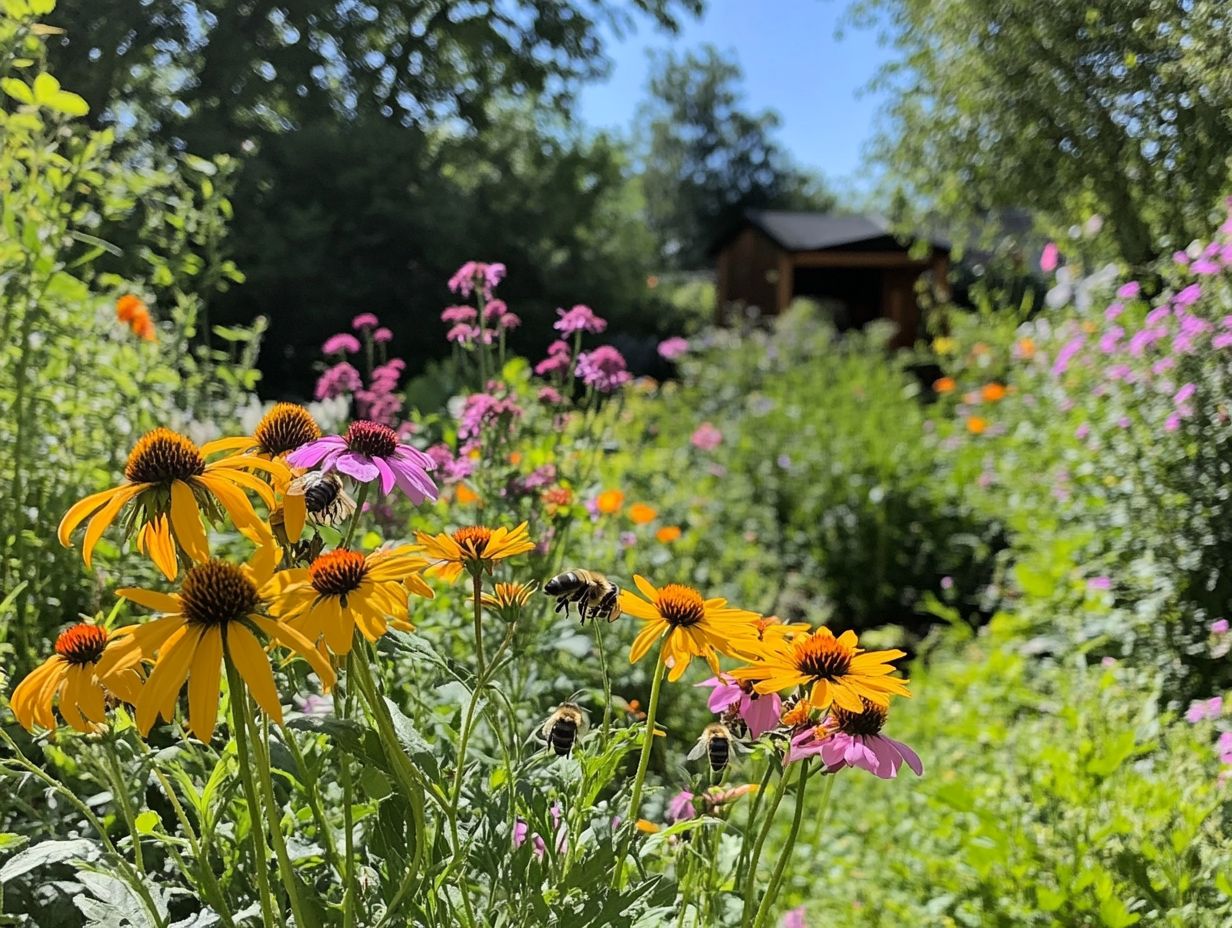
What are some simple ways to support local bee species?
Some simple ways to support local bee species include planting native flowers and avoiding pesticides in your yard or garden. Adding an insect hotel can provide shelter for solitary bees, and a water source like a bee bath will keep them hydrated.
Why is it important to support local bee species?
Local bee species play a crucial role in pollination and maintaining a healthy ecosystem. Supporting them helps to preserve biodiversity and food sources for other animals. Creating pollinator gardens and planting seasonal flowers can enhance local bee populations.
How can I create a bee-friendly environment in my garden?
You can create a bee-friendly environment in your garden by providing a variety of flowers that bloom throughout the year, ensuring a water source, and leaving some areas of soil exposed for nesting. This means leaving some areas of bare ground for bees to burrow into. Consider planting native wildflowers and integrating flower shapes that cater to different types of bees.
What types of plants are best for supporting local bee species?
Native plants are the best choice for supporting local bee species as they have evolved to be the most beneficial for these bees. Some examples include goldenrod, sunflowers, and purple coneflower. Tree blooms from local flora are also excellent at attracting bees.
What should I do if I encounter a bee hive in my yard?
If you encounter a bee hive in your yard, it s crucial to leave it alone and contact a local expert immediately. Attempting to remove the hive yourself can be dangerous for both you and the bees. Search online or check with local gardening clubs to find local beekeepers who can assist.
Can I support local bee species if I live in an urban area?
Yes, even if you live in an urban area, you can still support local bee species. Consider planting native flowers in containers on your balcony or creating a bee-friendly rooftop garden. Urban beekeeping initiatives can also offer a hands-on way to support bee populations.

